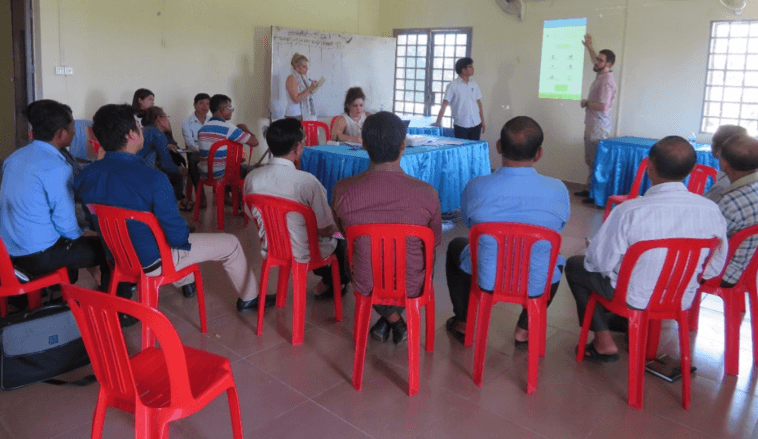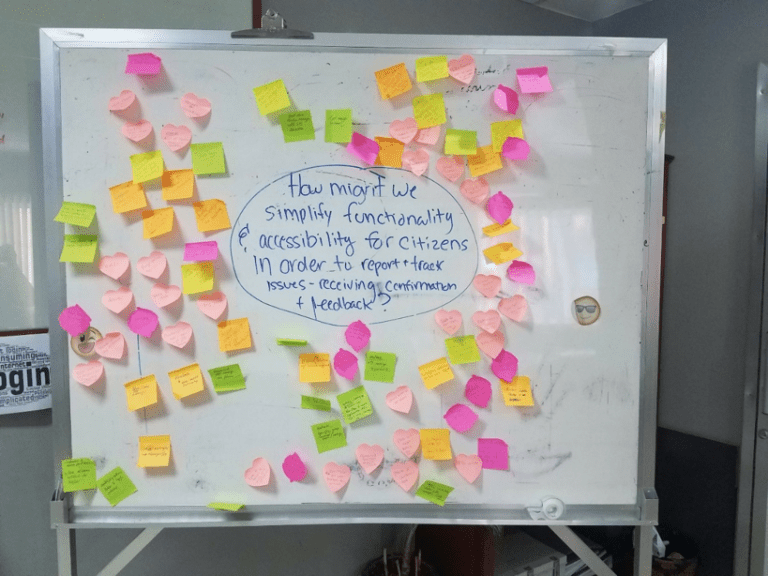Blog
The ghosts of user-centered design

Sitting in the Cambodian humidity, in an open-air council hall in Pursat with storm clouds rolling in the distance, I had to wonder if I would have found myself here were it not for the concept of user-centered design.
Two years earlier, in 2015, Pact’s innovation team, which I lead, had visited Cambodia to source new innovations for our existing governance project, which was helping communities make big improvements in citizen participation. TRANSMIT, a technology solution that would allow citizens and government officials to virtually submit and respond to issues of public concern, emerged as the standout. As envisioned, government and citizen leaders would enter into the app complaints raised by Cambodians during local council meetings. The app would then compile the complaints in an online database where officials could address them and citizen could track what had been done, boosting accountability.
TRANSMIT, which stands for Tracking and Sharing Multi-Sector Issues with Technology, was soon awarded nearly $100,000 from USAID’s Development Innovations Cambodia. In early 2016, it was featured in Forbes Asia, with the article highlighting TRANSMIT’s potential for combatting Cambodia’s rampant government corruption. We were thrilled.
Yet sitting in the council hall earlier this summer, TRANSMIT’s early success had plateaued. We found ourselves re-engaging our end users to try to discover what factors had led to the solution's low user uptake.
The primary purpose of Pact’s innovation team is to create enabling environments to catalyze new ideas and build the capacity of our country offices to think more creatively and entrepreneurially. Since its launch in 2013, the team has consistently both embedded design-thinking principals in our work and run comprehensive user- or human-centered design exercises as a part of our incubation process. But in the case of TRANSMIT, conflicting priorities had prevented us from backstopping the country office with support during the first six months of development; we had to leave the solution’s build-out to a capable, smart and well-intentioned yet overburdened country team.
As months went by and I periodically checked in, I heard cautious optimism turn to uncertainty. It “seemed” to be working, and demand was ever-present. But around the two-year mark, despite well-resourced and researched efforts, uptake had stalled.
“The truth is, we did consult extensively with stakeholders on the ground, we did work intensively with our service provider, we did do user testing of early versions of the solution, and we did seek continuous feedback from our users,” recalls Pact’s Cambodia country director, Zach Center. “And yet we still failed.”
But why?
Zach explains it this way, and in retrospect, I agree: “I think the story here is that UCD takes us deeper into these approaches, which we’d been using for years, to draw truly empathetic insights. This is where so much of the industry is coming up short. We tick the user-centered boxes on a regular basis, but how well do we truly know our users? How well are we actually listening?”
It was time to rethink TRANSMIT, so together the innovation and Cambodia teams undertook a two-week design exercise with end users, focusing on both their motivations for wanting the tool and on their experience as users. Through qualitative HCD methodologies, including surveys, focus groups, large-group discussions, secondary research and creative activities, our joint team attempted to empathetically connect with the TRANSMIT end-user experience.
Ultimately, we built three new clickable prototypes using the app Mockingbot. While each varied in functionality and user experience, all of them aimed to offer a more simplified, accessible tool for reporting, tracking and resolving citizen complaints.
Then we tested them with real users. This yielded valuable insight on needed technology improvements, but it also revealed mixed motivations and incentives for using the tool – something we will explore further.

It was the presentation of the prototypes on this hot, balmy day in the Pursat council hall that brought me to reflect on the past two years. As we walked users through the new prototypes, I had to ruminate on our journey so far:
- Although our Cambodia country office has been directly engaging end users for 25 years, had we approached this concept through true user-centered design, we would have gone beyond superficial ‘engagement’ or ‘consultation,’ to develop a deeper understanding and connection with users regarding their motivations and needs.
- Had we built prototypes from the beginning, we would have learned firsthand how cumbersome our tech solution was.
- Most important, had we given up on everything, we would have closed the door on the plethora of ideas that ended up coming out of our prototype session in Pursat.
Test expert assumptions. Co-create. Prototype. Fail fast and iterate.
These tenants of innovation and design thinking, while fundamental to an innovation team, were lost in the fray of a busy country team building a new and potentially transformative solution for the first time. Although this road took longer than it might have, the journey still afforded us the incredible opportunity for reflection and introspection – the chance to learn and test and iterate for the end user.
We still have more work to do, but by using human-centered design to take a step back and truly listen, we’ve made important progress.
Better late than never.